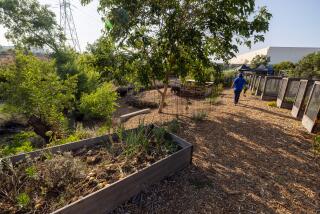Programs try to save students from ‘summer slide’ in academics
- Share via
In a corner of the San Fernando Valley, amid auto body shops and Salvadoran pupusa restaurants, a Hawaiian summer is in full swing.
At Camp Akela, located at Noble Avenue Elementary School in North Hills, kindergartners read about rainbow fish and draw them. Other students study volcanoes, create travel journals, dance the hula and even play in a portable pool.
But the students, most of them low-income English learners, are also learning literacy, math facts and science and are honing writing skills with “coaches” dressed in leis, tropical shirts and grass skirts.
Melding education with typical summer fun, the program is part of a statewide campaign aimed at combating a growing problem known as the “summer slide,” the loss of academic skills during the vacation months. Decades of research, including a new study by the Rand Corp., has documented that children lose two to three months of reading and math skills while on break and that the problem is particularly acute for lower-income children with limited access to travel, museums, libraries and other enriching experiences.
A 2007 study by Johns Hopkins University, for instance, found that the cumulative effect of summer learning loss during the elementary school years accounts for two-thirds of the achievement gap between lower-income students and their more affluent counterparts by ninth grade.
“There is a real disparity in summer learning opportunities for children in disadvantaged communities,” said Steven Wirt of the Partnership for Children and Youth, an Oakland-based nonprofit promoting the California summer learning campaign.
“We want to be sure these kids are not subjected to this devastating summer learning loss. It becomes exponentially detrimental as students move through their academic careers and later on in life,” he said.
In addition to academic backsliding, research has also found that children gain weight three times faster during summer than in the school year because many children lose access to exercise and more nutritious school lunches.
But while efforts are underway to boost summer learning, the programs reach only a small percentage of the students who need them. A survey by the Afterschool Alliance, a Washington-based advocacy group for after-school programs, found that 1.8 million California children participated in summer learning programs last year — but that an additional 3.2 million wanted to enroll.
The David and Lucile Packard Foundation has launched a $20-million, eight-year summer learning initiative aimed at reaching 100,000 children in 10 regions throughout the state. Foundation spokesman Jeff Sunshine said the grants are aimed at providing creative programs that include academics, nutrition, the outdoors and arts, music and cultural enrichment.
“When kids are happy in the summer, they’re more open to learning,” Sunshine said. “It’s a real way to ignite learning and close the achievement gap.”
Think Together, a Santa Ana-based group, is providing science, math and technology skills for 800 students in three Santa Ana schools with its $125,000 Packard grant.
The Whittier City School District received its first $110,000 grant from Packard last year, allowing it to nearly double its 2011 summer program to 760 students. Although that’s a fraction of the district’s 6,500 students, it still helps, given that budget cuts caused the district to severely pare back its summer school several years ago, according to Becky Shultz, director of Whittier’s after-school programs.
The foundation also gave Whittier officials a new concept for summer learning that prompted them to move from more traditional academics to what they call “disguised learning” — academics wrapped in a summer camp setting. The program’s theme, “Passport to the World,” helps students boost academic skills through global cultural activities.
Jenny Hernandez, Whittier’s instruction specialist, said that last year’s summer program participants increased their reading fluency, read more books, gained social skills and improved their eating habits.
“Children like it 100% more,” she said, referring to the summer camp approach. “They’re excited and come back to school in the fall with an enthusiasm for learning.”
In L.A. Unified, nine of the 99 LA’s BEST summer programs are funded by Packard and serve 1,100 students. About 100 children attend Camp Akela at Noble Elementary — less than 10% of the school’s largely low-income population.
Cara Schneider, Noble’s principal, said her students particularly tend to lose math skills. Many of them are confined to the indoors with little enrichment and often are not allowed even to play outdoors because of safety concerns, she said.
“A lot of the kids are bored,” she said. “They watch TV, play video games and fight with siblings.”
Fourth-grader Alondra Anguiano said Camp Akela has opened her world to the untried and unknown: hearing the ukulele, learning the Hawaiian alphabet and the traditional dress and rituals of the Pacific Islanders. Along the way, she said, she has improved her reading speed and read “really fun books.”
“During the school year, it’s a lot of work and not that much fun,” said Alondra, the daughter of Mexican immigrants who said she now aims to visit Hawaii at least once. “But this program has really fun activities.”
More to Read
Sign up for Essential California
The most important California stories and recommendations in your inbox every morning.
You may occasionally receive promotional content from the Los Angeles Times.











